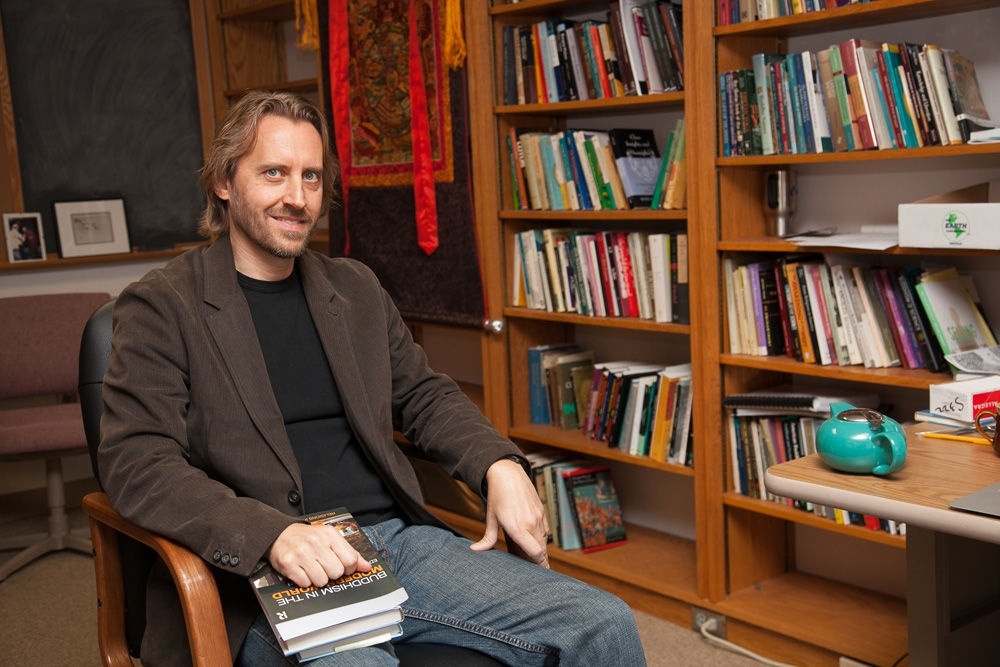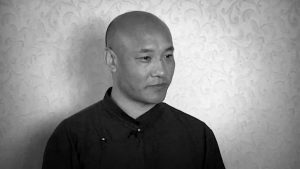
David McMahan is professor of Religious Studies at Franklin & Marshall College, Pennsylvania. In recent years he has offered the Buddhist Studies community a more nuanced and sophisticated understanding of Buddhism’s modern reinvention. His book The Making of Buddhist Modernism (Oxford University Press 2008), argues that Buddhist modernization was a conscious, collaborative effort by Asians and Westerners to arm Buddhism with new ideological tools to thrive in the brave new world of the 19th and 20th century.
Buddhistdoor Global: How does the study of how meditation is practiced today give insight into the modernization or secularization of Buddhism?
David McMahan: For well over a century, there has been some debate about how to classify Buddhism. In the 19th century in the West, it was hard to conceive of a “religion” without a creator god. Some characterized Buddhism as a system of ethics or a way of life. That ambiguity has made it more feasible for various facets of Buddhism to trickle into realms of life that fall into the modern category of “secular.” Meditation is the area that has broken off completely and taken on a life of its own in secular contexts.
The last couple of decades have brought about truly historic developments in the history of Buddhist and Buddhist-derived meditative practices. Keep in mind that such practices began among counter-cultural renunciates. They were maintained mainly by specialist monks for centuries, and while lay meditation was not unheard of, it was the exception until the beginning of mass meditation movements in Southeast Asia a little over a century ago. Since then, meditative practices have moved not just beyond the monastery but beyond Buddhist institutions altogether. They are being put to use for purposes that could not have been imagined in the past: enhancing productivity and efficiency, doing better on exams, pain relief, quitting smoking, and so on.
This is possible in the US because meditative practices derived from Buddhism have been rhetorically and practically re-framed as secular and therapeutic in a modern medical sense. This reframing allows government money to flow for research and for these practices to be taught in public schools and universities, which are not permitted to promote religion.
The casting of these practices as secular has also cut them loose from traditional Buddhist ethical, philosophical, and cosmological frameworks, all of which have been an essential part of these practices in the past. Presented without this context, they have soaked up all kinds of other values, purposes, and ethical orientations from the broader culture. Thus we have mindful money-management, mindful sex, mindfulness for relieving stress brought on by the frenetic work-pace of modern life.
BDG: Mindfulness, neuroscience, and related developments seem to encapsulate the “modern” secular incarnation of Buddhism. Yet this seems to be a conflicted phenomenon, with non-religious mindfulness teachers trying to disassociate themselves from Buddhism, or Buddhist leaders or scientists trying to assert Buddhist inspiration for many developments in neuroscience. What do these conflicting interests mean for your analysis of Buddhist secularisms?
DM: Different people have different interests and stakes in the embrace of mindfulness and in the relationship between mindfulness and Buddhism. Some have a vested interest in assuring others that mindfulness is not “religious” but psychological, therapeutic, and scientific. They want to distance themselves from any “supernaturalism” and from the baggage that the term “religious” often carries among modern, educated people. Others (or in some cases even the same people) might want to avail themselves of the mystique of “Eastern wisdom,” and the idea that in this world in which everything seems new, there are techniques handed down from ancient times.
All of this relates to questions of legitimacy and authority. Some Buddhists want to draw from the immense prestige of science to bolster the legitimacy of Buddhist ideas and practices. Others may be discouraged by the dominance of “materialistic” science and believe that Buddhism can either extend science beyond materialistic bias or provide an altogether different way of thinking and talking about reality that is outside the hegemonic discourse of the sciences.
BDG: Can you give a couple of examples of a multi-nodal process of simultaneous modernization, and how they have affected practice on the ground?
DM: While Western categories and ideas have undoubtedly been important to the modernization of Buddhism, it is a mistake to think that this process has simply been a matter of Westerners taking Buddhism into the modern world and Asians being passive traditionalists. To the contrary, most Buddhists who began reform movements in the late 19th century were Asians, like Anagārika Dharmapāla in Sri Lanka (then Ceylon), Sōen Shaku in Japan, and Taixu in China. They borrowed ideas from the West but also used them to critique Western colonialism and imperialism.
In Ceylon, Dharmapāla combined elements of British Victorian mores with Buddhist monastic codes and developed new ways for laity to conduct themselves (Stephen Prothero discusses this in his book on Henry Steel Olcott, The White Buddhist). He also made a big impact on the German-American Paul Carus at the World’s Parliament of Religions in Chicago in 1893. Carus then became fascinated by Buddhism and eventually wrote The Gospel of Buddhism, a collection of translated sutras (plus one that Carus himself wrote!) that then got translated into Japanese and used in monastic curricula there.
So the modernization of Buddhism was multi-nodal not in the sense that different people in different parts of the world were creating modernized iterations of Buddhism independently, but each was contributing to creating an inter-related global discourse.
BDG: During your speech at the “Buddhism in the Global Eye: Beyond East and West” conference in Vancouver in August, one of the audience members assigned the term “easy pass” to Buddhism since a significant number of Westerners do not even consider it a religion, making it a relative irrelevance in the debate on the separation of church and state. Is the “irrelevance” of Buddhism a good thing, or is Western public discourse on faith and society impoverished in some way for not having a more prominent Buddhist voice (if such a thing were possible)?
DM: I think this issue suggests the particular contours and limits of the typical binary division of human life into rigid categories of “religious” and “secular.” These concepts were developed with Christianity representing the prototypical “religion.” Because Buddhism doesn’t always fall neatly into these categories thus conceived, it has gotten a “pass” in some respects.
For example, some state-funded programs in Buddhist Studies in the US have been able to function almost as Buddhist seminaries. And of course many Buddhist meditation practices, even if their origins are acknowledged, are presented as universal and practicable by anyone of any—or no—religion.
Buddhism’s difficult fit with the Western iterations of the religious/secular binary has, in some ways, been advantageous to its adaptation and acceptance in the West. Westerners can be “into” Buddhism, adopting some of its teachings and practices without necessarily identifying as Buddhist or joining Buddhist organizations. Buddhist organizations, in turn, can function as “religions” with the same protections and tax-exempt status as others.
More orthodox Buddhists may decry those who are “into” Buddhism. Thomas Tweed called them “nightstand Buddhists”—people who have Buddhist books on their nightstands but don’t have a high level of commitment or join Buddhist institutions. Nevertheless, they have popularized Buddhist ideas, practices, and images in the West, making aspects of the Dharma more familiar and accepted.
BDG: How do you see the trajectory of Buddhist “secularism” developing in the West over the next decade? Will it become even more secular than it already is, or will we see an increased “porousness” between the religious and the secular?
DM: I think it’s likely that different varieties of Buddhism will continue to flourish. I doubt that secularized Buddhisms will displace more orthodox forms altogether. Just as Buddhism has popular and elite forms in Asia, secularized Buddhism in some places is almost like a form of popular religion.
The term “popular religion” is often used to refer to the non-institutionalized practices of common people—it doesn’t require a lot of in-depth knowledge, it is relatively free-form, it is not dependent on institutions, and it is often concerned with this-worldly benefits. It also can exist in a kind of uneasy relationship with more orthodox and institutional forms, while still overlapping with them.
Secularized Buddhism is an unusual kind of elite-popular religion. While monasticism is thriving in places like Taiwan and Southeast Asia, it may be that much of Buddhism in the West will exist at this popular level rather than the institutional level. It is practiced by people who may not identify exclusively as Buddhists, but have Buddhist ideas and practices as part of a repertoire of ways of navigating the world. In some respects this resembles the way it has always been in East Asia, where many people have practiced aspects of different traditions (Buddhism, Confucianism, Daoism) without necessarily being exclusively identified with any one.














